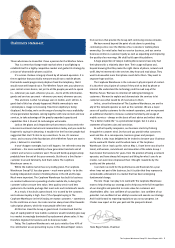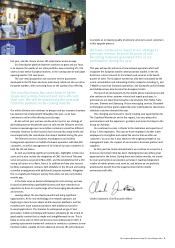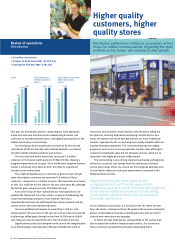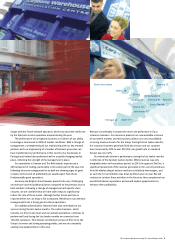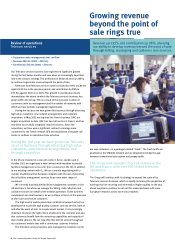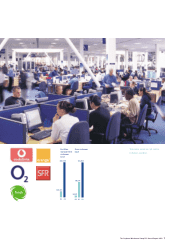Carphone Warehouse 2002 Annual Report Download - page 13
Download and view the complete annual report
Please find page 13 of the 2002 Carphone Warehouse annual report below. You can navigate through the pages in the report by either clicking on the pages listed below, or by using the keyword search tool below to find specific information within the annual report.
The Carphone Warehouse Group PLC Annual Report 2002 11
Funds in hand
after significant
investment
i
impairment review was undertaken by the Board in accordance with FRS
11 at the period end and did not give rise to any additional charge.
Earnings per share (EPS)
Headline EPS, before amortisation of goodwill and exceptional items,
was 4.41p, compared to 5.00p in the previous period.
Balance sheet and cash generation
At 30 March 2002, the Group had net cash and short-term investments of
£53.0m compared to £102.9m at the end of the previous period. The
Group continues to generate strong cash flow from operating activities
albeit absorbing significant working capital after taking advantage of
favourable supplier early settlement terms. The Group has incurred
capital expenditure on opening new stores, and on continued investment
in the Group’s operational infrastructure. The level of capital expenditure
is expected to reduce further in the year ahead with fewer store
openings and the Group focusing on net cash generation. Our working
capital management is closely attuned to this aim of cash generation, as
reflected in the levels of stock and debtors at year end.
Net assets decreased during the period from £434.5m to £408.0m,
reflecting the exceptional charges made during the period, but the
Group’s liquidity ratio has remained constant at 1.4, reflecting the
strength of the Group’s financial position.
Financing and treasury
The Group’s operations are financed almost entirely by retained profits
and equity. The Group has a multi-currency 3year revolving credit facility
of £150m expiring on 14 April 2003, of which £24.7m was utilised at the
period end, albeit offset by other cash and short-term investments.
Funding of our subsidiaries is, apart from local overdraft facilities,
arranged and monitored centrally and on an arm’s length basis.
In the absence of significant debt within the Group, liquidity and
interest rate management is concentrated on maximisation of in-hand funds
through good day to day cash management and maximisation of our return
on such monies, ensuring at all times that investments are within
acceptable risk parameters. At the time of peak working capital requirement
the Group mitigates the cost of drawing on the revolving credit facility with
more flexible uncommitted short-term borrowings.
The Group is exposed to limited cross-border foreign currency
contractual commitments, and where these commitments are significant
they are hedged at inception by forward currency contracts. We aim to
protect overseas subsidiary reserves from foreign exchange losses by intra-
Group borrowings in the appropriate currencies and by currency swaps.
The Board’s strategy for financial risk management includes the use
of financial instruments. Such instruments are used for risk management
purposes only and the Group does not trade or speculate in any other
financial instruments.
Shareholders’ funds and return on investment
Total shareholders’ funds were £407.3m at the period end compared to
£432.8m at 31 March 2001. As in previous periods the Board has decided
to retain these funds for continued investment in the development of the
Group and the future enhancement of shareholder value and is therefore
not proposing a dividend for the period.
Post tax earnings before amortisation and exceptionals generated a
return on average shareholders’ funds, excluding goodwill on minority
interests acquired in the previous period, of 14.1% compared to 23.3%
for the previous period.
Financial controls
The management structure of the Group ensures that day-to-day
financial controls are the responsibility of local operational managers,
under the overall supervision of Group management. The introduction of
Group management functions and shared services will lead to more
centralisation of these controls and processes in the future. Comprehensive
systems of budgetary control are in place, with regular reporting to the
Board. During the period the Board reviewed systems of internal control
to ensure compliance with the Turnbull guidelines.
The internal audit department reports to the Audit Committee at least
three times a year and reviews all key business units on a rolling basis.
Accounting standards
During the period a number of Financial Reporting Standards (FRSs)
were issued. These have been implemented where required together
with Urgent Issues Task Force (UITF) instructions.
The accounting policies adopted during the period are set out on
pages 30 and 31 and are consistent with those applied in the prior
period with the exception of FRS 19 which was applied in this period and
gave rise to a prior period adjustment as detailed in note 10 to the
financial statements.
Roger Taylor, Chief Financial Officer
Cash and short-term investments 2002 2001
£m £m
Cash 20.7 67.5
Overdrafts and short-term loans (10.6) (10.8)
Long-term loans (24.7) (0.2)
Bonds and FRNs 14.4 16.3
Equities and equity funds 34.8 21.5
Other short-term investments 18.4 8.6
53.0 102.9
Cash flow 2002 2001
£m £m
Operating cash inflows 29.4 43.7
Capital expenditure (net) (38.3) (71.1)
Acquisitions and investments (net) (43.4) (54.1)
Tax and interest (9.1) (4.6)
Financing 24.8 133.5
Net cash (outflow) inflow (36.6) 47.4
Net cash and short-term investments


